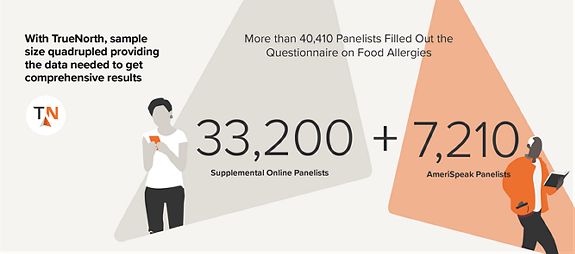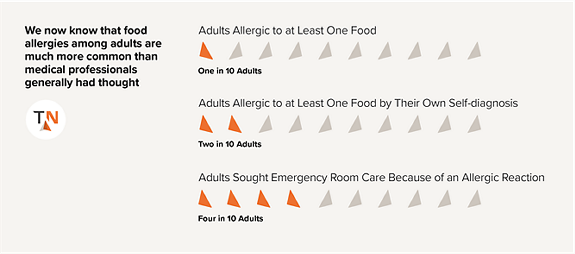
TrueNorth’s landmark—and peer-reviewed—study on food allergies
In 2019, the Journal of the American Medical Association published a 4,400-word article, Prevalence and Severity of Food Allergies Among U.S. Adults, that was based entirely on a set of national surveys TrueNorth conducted with two top-tier universities. The report was picked up by a wide range of media, from health and medical websites to CNN and CBS.
Quick Background
There are two main ways of conducting a survey. The gold standard is a probability survey, in which respondents are recruited to form a representative subset of the U.S. population. Because of their representativeness, probability surveys have the highest chance of producing accurate findings. TrueNorth’s parent, AmeriSpeak®, which NORC at the University of Chicago launched in 2015, is especially adept at probability surveys.
The second type is known as a nonprobability survey. Typically they can’t come close to the precision of a probability panel. They are solely opt-in, where individuals seek out and sign up to take the surveys, and are done exclusively online, which leads to underrepresentation of some important groups and overrepresentation of others. Their low cost and scale makes them attractive, however.
Our Challenge
Although childhood food allergies are reasonably well studied, little was known about the rate and severity of food allergies among adults. Working with researchers from Northwestern University and Stanford University, we were brought in to find that out.
Specifically, we were asked to determine how many American adults have had severe symptoms that indicate a food allergy and how many had diagnosed an allergy on their own, and to report these rates by gender, age, race, ethnicity, and other demographic categories. We were also asked to give demographic breakdowns of how many people had specific food allergies, such as pistachios or sesame seeds, that afflict very few people.
Attaining reliable estimates from questions that would get few “yes” answers required an extraordinarily large survey sample. We used an in-depth AmeriSpeak questionnaire that was completed by 7,210 panelists, but even that response was too small to yield reliable results at a granular level. Expanding the probability survey was out of the question, as the needed number of respondents would have cost millions of dollars.


The Pivot
As a cost-effective alternative to a larger AmeriSpeak panel, we turned to a third-party online consumer polling company to ask the same set of questions of its opt-in nonprobability panel. More than 33,200 panelists filled out this supplemental online questionnaire, which more than quadrupled our sample size, providing the breadth we needed to get comprehensive results. We then used our TrueNorth calibration tool to correct the inherently biased findings from the nonprobability survey and bring them within the margin of error of a more unbiased probability survey.


Our Impact
We now know that food allergies among adults are much more common than medical professionals generally had thought. As our study discovered—and as the Journal of American Medical Association (JAMA) and other media outlets reported—one in 10 adults is allergic to at least one food, though almost twice that number believe they are by their own self-diagnoses. We also now know that among food-allergic adults, half have had severe reactions and two in five have had to seek emergency room care at least once because of an allergic reaction.
In addition, our methodology and findings were thoroughly reviewed by professional peers, who judged them to be sound and accurate. This showcases that TrueNorth can clean up faulty data and give researchers an affordable third way to get the trustworthy information they need.
To use TrueNorth for your next research study, email us at TrueNorth@norc.org
